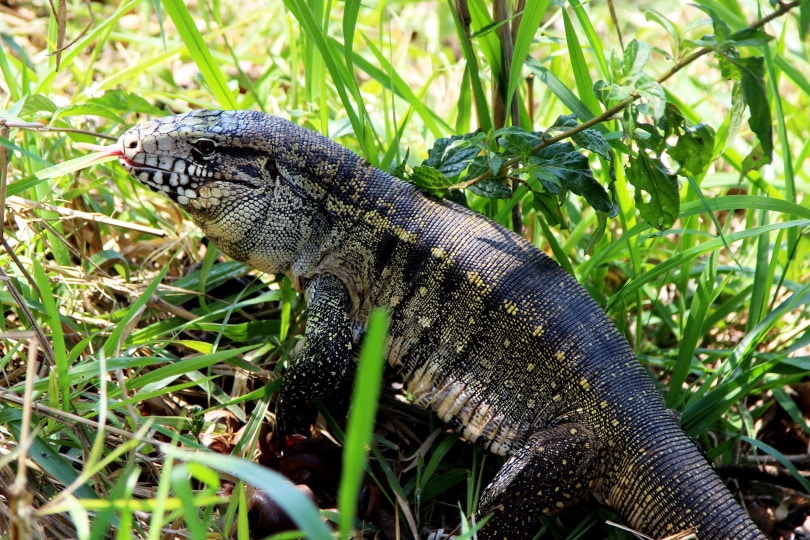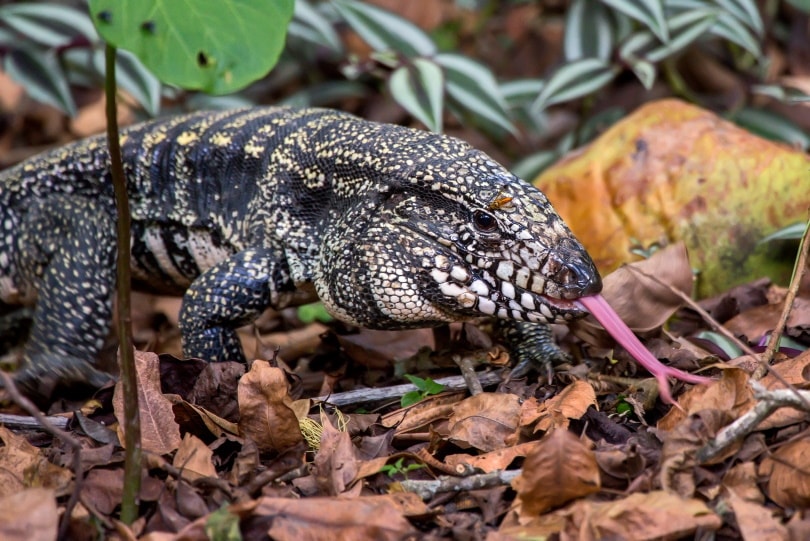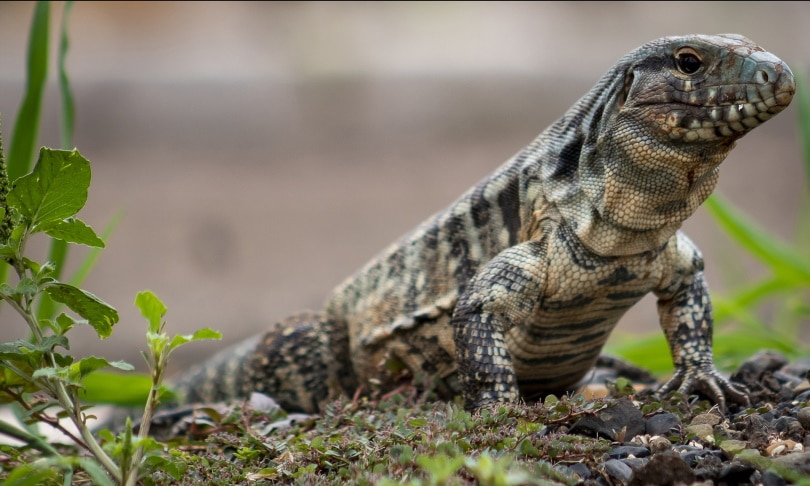How Big Do Black and White Columbian Tegu Get

Tegus are massive lizards, commonly mistaken for monitors due to their large stature and intimidating looks. Many species of tegu can grow to lengths in excess of five feet and weigh up to 20 pounds, which is why they've become invasive species in many places. Their natural habitat lies across South and Central America, where they can be found in diverse environments ranging from near deserts to tropical rainforests.
In total, there are more than 400 species of lizard that are classified as tegus. They span a natural range of more than 1,000 miles, and invasive populations live in areas around the world, including several stable populations in Florida. We're going to take a closer look at 14 of the most well-known tegu species and morphs, some of which are even kept as pets.
14 Types of Tegus
Argentine Tegus
1. Black and White Tegu

Black and White Argentine Tegus are the most popular and best type for keeping as pets. They're very large, but unlike many tegus, can be trained for handling. With regular handling, they become quite docile and gentle, though they can certainly be aggressive without regular handling.
They're about five feet long on average and live for 15-20 years in captivity. As the name suggests, these tegus are black and white in color with bands and speckles of both colors. They're common on the pet market, and prices range from $200-$500 on average.
2. Yellow Tegu
Yellow Tegus are not available on the pet trade. They're similar in appearance to Black and White Tegus, except they have yellow and black coloration rather than white and black. Additionally, Yellow Tegus are smaller, generally weighing 8-10 pounds at an average length of two to three feet.
3. Red Tegu
Argentine Red Tegus aren't quite the longest tegus. Females top out around three feet in length while males reach a max length of 4.5 feet. However, they are the heavyweights of the tegu world, with adults weighing around 50 pounds! They sport a reddish-brown color with black stripes across the body and broken white stripes running their length, though juveniles tend to be a brownish-green color; the red only sets in as the lizard matures.
Colombian Tegus
4. Gold Tegu

Tupinambis teguixin is the true Gold Tegu, but several other species of tegu were mistakenly believed to be part of the same species, so they've all been given the name of Gold Tegu, despite the fact that they're actually four different species. T. cryptus, T. cuzcoensis, and T. zuliensis are all closely related and all referred to as Gold Tegus, but it was discovered in 2016 that they're completely separate species, which is why they each have their own scientific name.
5. Four-striped Tegu
Tupinambis quadrilineatus, more commonly known as the Four-Striped Tegu, is a very rare lizard that calls central Brazil its home. Almost nothing is known about this tegu species.
6. Rodonia Tegu

This is another tegu species about which little is known. Native to Brazil, the Rodonia Tegu can be found throughout the northwestern part of the country. Less colorful than many tegu species, the Rodonia has a dark black stripe running down each side of its body with a pattern of brown and black splotches running down its back and the length of its tail.
7. Swamp Tegu
Tupinambis palustris, the Swamp Tegu, is another Brazilian Tegu. This species is found exclusively in Sao Paulo, so it has a very narrow natural habitat. Not much is known about the Swamp Tegu aside from where it can be found.
8. Matipu Lizard
Native to South America, the Matipu lizard is the most recently discovered species of tegu. You can read about it in the Journal of Herpetology where news of the species' uncovering was first published in February 2018.
9. Caiman Lizards (Water Tegu)
Caiman lizards are also known as Water Tegus, though, technically, they're cousins. Still, they're all part of the same family, and they have very similar traits. Caiman lizards can range from 2-4 feet long and weigh up to 10 pounds when they're fully grown. They're excellent climbers and also adept swimmers. These semi-aquatic lizards are often preyed on by jaguars, crocodiles, snakes, and more in the wild, and the ability to climb and swim to safety is what allows them to survive.
10. Crocodile Tegu
These are very small tegus, topping out around 18 inches. They're also extremely rare and aren't available on the pet trade. In the rare case that one does end up for sale, they usually cost upwards of $10,000. Even in the wild, it's hard to find a Crocodile Tegu, though they share a natural range with Caiman lizards. Crocodile Tegus are colorful and vibrant with green heads and red and gray markings down their bodies. They're also very good swimmers, which is where their name comes from.
Paraguayan Tegus
11. Chacoan White-Headed Tegu
These are one of the few Paraguayan tegu species, and they're often called the Paraguayan Black and White Tegu. They're named for their heads, which are all-white in color once the tegu reaches maturity. These tegus are quite similar to Argentine Black and White Tegus in looks as well as temperament, and they're often sold on the pet market for a similar price.
Tegu Morphs
12. Blue Tegu
Blue Tegus are a color morph of the Argentine Black and White Tegu with a light blue tint to their bodies, which is most easily seen in males that are fully mature. In most regards, these are no different from a standard Black and White Tegu, though they tend to be a bit smaller and will usually cost you a bit more.
13. Albino Tegu
Albino Tegus are a color morph of the Black and White Argentine Tegu that has no pigment. This leads to all-white or mostly white tegus. Some can even have pale spots or bands in red or black that are just barely visible. Because Albino Tegus are so rare, they generally sell for several thousand dollars when they make appearances in the pet trade.
14. Purple Tegu
The name Purple Tegu is a little misleading because these tegus aren't actually purple. They're usually black and green, but they're called Purple Tegus because it's believed that they're a cross between a Blue and a Red Tegu.
How Do Tegus Become Invasive?
Well-meaning people purchase pet tegus without understanding exactly what they're getting or what goes into tegu care. Expecting a pet the size of an iguana, they generally have no idea that their tegu could be half the size of Godzilla when it's grown. Before they know it, they have an aggressive, gigantic lizard in their home that they don't have the means to care for.
Not knowing what to do, the tegu gets released into the wild. But because these resilient reptiles live comfortably in so many habitats, it's easy for a released tegu to adapt to its new environment. Once this happens, all it takes is two tegus chancing to meet and a population can begin. In some cases, several tegus may have even been released together, creating the perfect situation for an invasive population to exist.
Tegus as Pets

Some tegus have done well in captivity and are now rather common pets. These species are often bred in programs by competent breeders, so it's easy to find captive-bred specimens in the pet trade, rather than wild-caught ones. Unfortunately, this isn't the case with every type of tegu. Some tegus, though popular as pets, don't have large breeding programs producing them, which means most specimens are wild-caught.
It's important to understand what you're getting into with a tegu. While some species may remain rather small, many tegus will be three feet or longer when mature. They require ample amounts of space and considerable care. But they're also incredibly intelligent reptiles. In fact, tegus have even been housebroken before, so it's kind of a unique pet in that regard.
Conclusion
Tegus are a diverse group of lizards that can range in size from just 18 inches to over five feet! Some of the heaviest specimens can even weigh more than 50 pounds! These lizards are colorful and stout, but not much is known about many tegu species. Some of them have even turned out to make good pets, but you need to know what you're getting into before committing to keeping a tegu, as they have extensive care requirements and can grow to massive sizes.
Featured Image Credit: Piqsels
An avid outdoorsman, Dean spends much of his time adventuring through the diverse terrain of the southwest United States with his closest companion, his dog, Gohan. He gains experience on a full-time journey of exploration. For Dean, few passions lie closer to his heart than learning. An apt researcher and reader, he loves to investigate interesting topics such as history, economics, relationships, pets, politics, and more.
Contents
- 14 Types of Tegus
- Argentine Tegus
- 1. Black and White Tegu
- 2. Yellow Tegu
- 3. Red Tegu
- Colombian Tegus
- 4. Gold Tegu
- 5. Four-striped Tegu
- 6. Rodonia Tegu
- 7. Swamp Tegu
- 8. Matipu Lizard
- 9. Caiman Lizards (Water Tegu)
- 10. Crocodile Tegu
- Paraguayan Tegus
- 11. Chacoan White-Headed Tegu
- Tegu Morphs
- 12. Blue Tegu
- 13. Albino Tegu
- 14. Purple Tegu
- How Do Tegus Become Invasive?
- Tegus as Pets
- Conclusion
- Related
How Big Do Black and White Columbian Tegu Get
Source: https://petkeen.com/types-of-tegu-lizards/